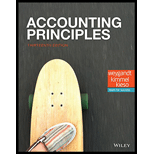
EBK ACCOUNTING PRINCIPLES
13th Edition
ISBN: 9781119411017
Author: Weygandt
Publisher: WILEY
expand_more
expand_more
format_list_bulleted
Concept explainers
Question
Chapter 26, Problem 16E
To determine
Introduction: The income statement shows the net income earned during the year. According to the
To prepare: The income statement.
Expert Solution & Answer
Want to see the full answer?
Check out a sample textbook solution
Students have asked these similar questions
Hello tutor solve this question accounting
I need help with this solution and accounting
Subject: general accounting
Chapter 26 Solutions
EBK ACCOUNTING PRINCIPLES
Ch. 26 - Prob. 1QCh. 26 - 2. (a) Explain the similarities and differences...Ch. 26 - Prob. 3QCh. 26 - Prob. 4QCh. 26 - Prob. 5QCh. 26 - Prob. 6QCh. 26 - Prob. 7QCh. 26 - Prob. 8QCh. 26 - Prob. 9QCh. 26 - Prob. 10Q
Ch. 26 - Prob. 11QCh. 26 - Prob. 12QCh. 26 - Prob. 13QCh. 26 - Prob. 14QCh. 26 - Prob. 15QCh. 26 - Prob. 16QCh. 26 - 17. What are some examples of nonfinancial...Ch. 26 - Prob. 18QCh. 26 - *19. (a) Explain the basic features of a standard...Ch. 26 - Prob. 20QCh. 26 - Prob. 21QCh. 26 - Prob. 22QCh. 26 - Prob. 23QCh. 26 - Prob. 1BECh. 26 - BE25-2 Tang Company accumulates the following data...Ch. 26 - Prob. 3BECh. 26 - Prob. 4BECh. 26 - Prob. 5BECh. 26 - Prob. 6BECh. 26 - BE25-7 The four perspectives in the balanced...Ch. 26 - Prob. 8BECh. 26 - BE25-9 Journalize the following transactions for...Ch. 26 - Prob. 10BECh. 26 - Prob. 11BECh. 26 - Prob. 1DIECh. 26 - Prob. 2DIECh. 26 - DO IT! 25-3 The standard cost of product 5252...Ch. 26 - Prob. 4DIECh. 26 - Prob. 1ECh. 26 - Prob. 2ECh. 26 - E25-3 Stefani Company has gathered the following...Ch. 26 - Prob. 4ECh. 26 - Prob. 5ECh. 26 - Prob. 6ECh. 26 - Prob. 7ECh. 26 - Prob. 8ECh. 26 - Prob. 10ECh. 26 - Prob. 11ECh. 26 - E25-12 Byrd Company produces one product, a putter...Ch. 26 - Prob. 13ECh. 26 - Prob. 14ECh. 26 - Prob. 15ECh. 26 - Prob. 16ECh. 26 - Prob. 17ECh. 26 - Prob. 18ECh. 26 - Prob. 19ECh. 26 - Prob. 20ECh. 26 - Prob. 21ECh. 26 - Prob. 23ECh. 26 - *E25-24 The loan department of Calgary Bank uses...Ch. 26 - Prob. 25ECh. 26 - Prob. 1PSACh. 26 - Prob. 2PSACh. 26 - Prob. 5PSACh. 26 - Prob. 7PSACh. 26 - Prob. 8PSACh. 26 - Prob. 9PSACh. 26 - Prob. 10PSACh. 26 - BYP25-1 Milton Professionals, a management...Ch. 26 - Prob. 2EYCTCh. 26 - Prob. 3EYCTCh. 26 - BYP25-4 The Balanced Scorecard Institute...
Knowledge Booster
Learn more about
Need a deep-dive on the concept behind this application? Look no further. Learn more about this topic, accounting and related others by exploring similar questions and additional content below.Similar questions
- An internal auditor's work would most likely affect the nature, timing, and extent of an independent CPA's auditing procedures when the internal auditor's work relates to assertions about the:a. Existence of contingencies.b. Valuation of intangible assets.c. Estimated salvage values of fixed assets.d. Valuation of related party transactions.e. Completeness of accounts payable. is it a or e?arrow_forwardCorrect answer needarrow_forwardPlease give correct answer this financial accounting questionarrow_forward
arrow_back_ios
SEE MORE QUESTIONS
arrow_forward_ios
Recommended textbooks for you
- Principles of Accounting Volume 2AccountingISBN:9781947172609Author:OpenStaxPublisher:OpenStax College
 Cornerstones of Cost Management (Cornerstones Ser...AccountingISBN:9781305970663Author:Don R. Hansen, Maryanne M. MowenPublisher:Cengage Learning
Cornerstones of Cost Management (Cornerstones Ser...AccountingISBN:9781305970663Author:Don R. Hansen, Maryanne M. MowenPublisher:Cengage Learning Managerial Accounting: The Cornerstone of Busines...AccountingISBN:9781337115773Author:Maryanne M. Mowen, Don R. Hansen, Dan L. HeitgerPublisher:Cengage Learning
Managerial Accounting: The Cornerstone of Busines...AccountingISBN:9781337115773Author:Maryanne M. Mowen, Don R. Hansen, Dan L. HeitgerPublisher:Cengage Learning  Principles of Cost AccountingAccountingISBN:9781305087408Author:Edward J. Vanderbeck, Maria R. MitchellPublisher:Cengage Learning
Principles of Cost AccountingAccountingISBN:9781305087408Author:Edward J. Vanderbeck, Maria R. MitchellPublisher:Cengage Learning Managerial AccountingAccountingISBN:9781337912020Author:Carl Warren, Ph.d. Cma William B. TaylerPublisher:South-Western College Pub
Managerial AccountingAccountingISBN:9781337912020Author:Carl Warren, Ph.d. Cma William B. TaylerPublisher:South-Western College Pub Financial And Managerial AccountingAccountingISBN:9781337902663Author:WARREN, Carl S.Publisher:Cengage Learning,
Financial And Managerial AccountingAccountingISBN:9781337902663Author:WARREN, Carl S.Publisher:Cengage Learning,

Principles of Accounting Volume 2
Accounting
ISBN:9781947172609
Author:OpenStax
Publisher:OpenStax College

Cornerstones of Cost Management (Cornerstones Ser...
Accounting
ISBN:9781305970663
Author:Don R. Hansen, Maryanne M. Mowen
Publisher:Cengage Learning

Managerial Accounting: The Cornerstone of Busines...
Accounting
ISBN:9781337115773
Author:Maryanne M. Mowen, Don R. Hansen, Dan L. Heitger
Publisher:Cengage Learning

Principles of Cost Accounting
Accounting
ISBN:9781305087408
Author:Edward J. Vanderbeck, Maria R. Mitchell
Publisher:Cengage Learning

Managerial Accounting
Accounting
ISBN:9781337912020
Author:Carl Warren, Ph.d. Cma William B. Tayler
Publisher:South-Western College Pub

Financial And Managerial Accounting
Accounting
ISBN:9781337902663
Author:WARREN, Carl S.
Publisher:Cengage Learning,
What is variance analysis?; Author: Corporate finance institute;https://www.youtube.com/watch?v=SMTa1lZu7Qw;License: Standard YouTube License, CC-BY